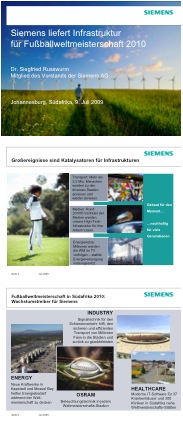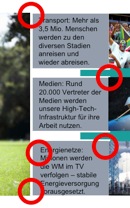Die letzte Zitrone des Monats ist eine ganze Weile her. Das liegt u.a. daran, dass wir hier nicht bloß lästern, sondern Zitronen nur dann vergeben, wenn wir aus den schlechten Beispielen auch etwas lernen können. Diesen Monat gibt es wieder etwas zu lernen, und zwar von Siemens.
Siemens ist Deutschlands größter Technologiekonzern. Der auch international in vielen Bereichen führende Weltkonzern steht für Hochtechnologie, z.B. wurde der ICE, in dem ich gerade sitze, von Siemens (mit-)gebaut.
Im vergangenen Monat berichtete Siemens auf einer Presseveranstaltung über seine Aktivitäten in Afrika, insbesondere im Zusammenhang mit der im nächsten Jahr stattfindenen Fußballweltmeisterschaft. Hierfür hat Siemens z.B. Kraftwerke in Kapstadt und Mossel Bay gebaut und Software für die medizinischen IT-Systeme in 37 Krankenhäusern bereitgestellt.
Hoffentlich hat das Unternehmen dabei mehr Sorgfalt walten lassen als bei der Erstellung der Folien zum Vortrag des Siemens-Vorstands Dr. Russwurm. Die Folien sehen auf den ersten Blick nett aus und zeigen emotionale Bilder (und es sind erfreulich wenige). Aber genauer darf man nicht hinsehen. Dann nämlich erkennt man, mit wie wenig Sorgfalt die Designer hier zu Werke gegangen sind.
Ganz deutlich sieht man das an der Ausrichtung der Elemente. Grob über den Daumen gepeilt stimmt das meistens. Aber intuitiv merkt man, dass hier etwas nicht genau passt. An der einen Stelle ein wenig zu hoch, an der anderen zu weit rechts, eben gerade so zurechtgerückt, nicht aber ordentlich entwickelt. Wer genau hinsieht, erkennt eine ganze Menge solcher Fehler.
Auch ansonsten wirken die Elemente eher lieblos auf die Folie geworfen. Manche Textboxen sind so eng an den Rand gequetscht, dass Sie fast aus den Boxen zu fallen scheinen, Abstände sind uneinheitlich, Texte sind ’mal fett, das andere Mal nicht und so könnte man weiter aufzählen.
Dagegen ist bei unternehmensinternen Vorträgen in Meetings nicht unbedingt etwas einzuwenden, denn da zählt der Inhalt deutlich mehr als die Form. Wenn aber ein Siemens-Vorstandsmitglied über Hochtechnologie-Projekte spricht und dabei explizit darauf verweist, dass Siemens kritische Infrastruktur zur Verfügung stellt, die den reibungslosen Ablauf der Weltmeisterschaften garantiert, dann ist es sehr wohl eine unterschwellige Botschaft, ob sorgfältig gearbeitet wird oder nicht.
Verwandte Artikel
Alle Zitrone-des-Monats-Artikel
Die vier Prinzipien professionellen Designs
Ein Menü aus Ideen



